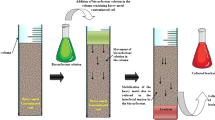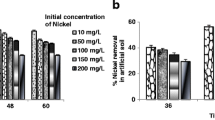Abstract
Using efficient and environmentally friendly techniques for the remediation of heavy metals contaminated soils plays a vital role in sustainable agriculture and public health. This study was conducted to assess the efficacy of biosurfactant-producing bacteria to remove Pb from a contaminated soil in the Agriculture Faculty of Isfahan (Khorasgan) Branch, Islamic Azad University, Isfahan, Iran, in 2019–2020 as a completely randomized design with three replications. The studied treatments were bacterial strain, biosurfactant, and control. Three native strains of bacteria (Bacillus pumilus, Alcanivorax dieselolei, Marinobacter hydrocarbonoclasticus) were used in this study. Considering the minimum inhibitory concentration (MIC) of Pb, Marinobacter hydrocarbonoclasticus was selected as the superior strain with respect to resistance to Pb. In order to evaluate the production capacity of biosurfactants in the superior strain, 4 tests (emulsification measurement, oil spreading, drop collapsing, and hemolytic activity) were used, which obviously approved the ability of this strain for biosurfactant production. Furthermore, the results of Pb detoxification by the treatments showed that the biosurfactant treatment had the greatest effect on the Pb removal from the soil compared to other treatments (27.37%), also there was no significant difference between the strain (i.e., Marinobacter hydrocarbonoclasticus) and control treatment. In general, it is concluded that using the abilities of soil bacteria and their metabolites, particularly in contaminated soils, will help researchers and stakeholders to improve soil and crop health and consequently public health, with low cost and high efficiency.








Similar content being viewed by others
REFERENCES
B. Anandaraj and P. Thivakaran, “Isolation and production of biosurfactant producing organism from oil spilled soil,” J. Biosci. Technol. 3, 120–126 (2010).
J. M. Andrews, “Determination of minimum inhibitory concentrations,” J. Antimicrob. Chemother. 48 (suppl_1), 5–16 (2002). https://doi.org/10.1093/jac/48.suppl_1.5
L. S. Araújo, S. Q. Silva, and M. C. Teixeira, “Develo** a biosurfactant to attenuate arsenic contamination in mining tailings,” Heliyon 7 (2), e06093 (2021).
I. M Banat, “Biosurfactants production and possible uses in microbial enhanced oil recovery and oil pollution remediation: a review,” Bioresour. Technol. 51, 1–12 (1995). https://doi.org/10.1016/0960-8524(94)00101-6
F. C. Bicca, L. C. Fleck, and M. A. Z. Ayub, “Production of biosurfactant by hydrocarbon degrading Rhodococcus ruber and Rhodococcus erythropolis,” Rev. Microbiol. 30, 231–236 (1999). https://doi.org/10.1590/S0001-37141999000300008
A. Bodour and R. M. Miller-Maier, “Application of a modified drop collapse technique for surfactant quantification and screening of biosurfactant-producing microorganism,” J. Microbiol. Methods 32, 273–280 (1998). https://doi.org/10.1016/S0167-7012(98)00031-1
J. Bremner, Total Nitrogen. Methods of Soil Analysis (Am. Soc. Agron. Mongrn, 1982), Vol. 10, pp. 594–624.
J. M. Bremner, “Nitrogen-total,” in Methods of Soil Analysis, Part 3: Chemical Methods (1996), Vol. 5, pp. 1085–1121.
D. G. Cooper and B. G. Goldenberg, “Surface active agents from two Bacillus species,” Appl. Environ. Microbiol. 53, 224–229 (1987). https://doi.org/10.1128/aem.53.2.224-229.1987
A. J. Das, S. Lal, R. Kumar, and C. Verma, “Bacterial biosurfactants can be an ecofriendly and advanced technology for remediation of heavy metals and co-contaminated soil,” Int. J. Environ. Sci. Technol. 14, 1343–1354 (2017). https://doi.org/10.1007/s13762-016-1183-0
C. U. Emenike, P. Agamuthu, and S. H. Fauziah, “Sustainable remediation of heavy metal polluted soil: A biotechnical interaction with selected bacteria species,” J. Geochem. Explor. 182, 275–278 (2017). https://doi.org/10.1016/j.gexplo.2016.10.002
G. W. Gee and D. Or, “Particle-size analysis,” in Methods of Soil Analysis, Part 4: Physical Methods (2002), Vol. 5, pp. 255–293.
F. Gravand, A. Rahnavard, and G. M. Pour, “Investigation of vetiver grass capability in phytoremediation of contaminated soils with heavy metals (Pb, Cd, Mn, and Ni),” Soil Sediment Contam.: Int. J. 30, 163–186 (2021). https://doi.org/10.1080/15320383.2020.1819959
A. H. Ibrahim and M. S. Mahmood, “Elicitation of biosurfactant production of Serratia marcessens by using biotic and abiotic factors,” Syst. Rev. Pharm. 11 (11), 1630–1638 (2020).
H. Islam Janpen, A. Kitten, and Y. Dassara, “Screening of biosurfactants producing bacteria and optimization of production process,” Am.-Eurasian J. Agric. Environ. Sci. 13 (2), 227–233 (2000). https://link. springer.com/article/10.1007/s13202-019-0619-8.
G. Jahanshah, I. Nahvi, H. Khodaverdee, M. Barani, H. Ghanavati, and S. H. Zarkesh, “Feasibility of heavy metals removal from compost by biosurfactant,” J. Water and Wastewater 3, 119–124 (2011) [in Persian]. https://www.sid.ir/en/Journal/ViewPaper.aspx?ID= 277576.
D. K. Jain, D. L. Collins-Thompson, H. Lee, and J. T. Trevors, “A drop-collapsing test for screening surfactant-producing microorganisms,” J. Microbiol. Methods 13 (4), 271–279 (1991). https://doi.org/10.1016/0167-7012(91)90064-W
A. Klute, Methods of Soil Analysis, Part I: Physical and Mineralogical Methods (Soil Sci. Soc. Am., Inc Publisher, Madison, 1986).
R. Makkar and S. Cameotra, “An update on the unconventional substrates for the biosurfactant production and their (new) applications,” Appl. Microbiol. Biotechnol. 58, 428–434 (2002). https://springer.longhoe.net/article/10.1007/s00253-001-0924-1.
N. H. Md Badrul Hisham, M. F. Ibrahim, N. Ramli, and S. Abd-Aziz, “Production of biosurfactant produced from used cooking oil by Bacillus sp. HIP3 for heavy metals removal,” Molecules 24 (14), 2617 (2019). https://doi.org/10.3390/molecules24142617
M. Meenakshisundaram and M. Pramila, “Detoxification of heavy metals using microbial biosurfactant,” Int. J. Curr. Microbiol. Appl. Sci. 6 (3), 402–411 (2017). https://doi.org/10.20546/ijcmas.2017.603.046
S. Mishra, Z. Lin, S. Pang, Y. Zhang, P. Bhatt, and S. Chen, “Biosurfactant is a powerful tool for the bioremediation of heavy metals from contaminated soils,” J. Hazard. Mater. 418, 126253 (2021).
M. Morikawa, Y. Hirata, and T. Imanaka, “A study on the structure–function relationship of lipopeptide biosurfactants,” Biochim. Biophys. Acta, Mol. Cell Biol. Lipids 1488 (3), 211–218 (2000). .https://doi.org/10.1016/S1388-1981(00)00124-4
F. Moshiri, H. Ebrahimi, M. R. Ardakani, F. Rejali, and S. M. Mousavi, “Biogeochemical distribution of Pb and Zn forms in two calcareous soils affected by mycorrhizal symbiosis and alfalfa rhizosphere,” Ecotoxicol. Environ. Saf. 179, 241–248 (2019). .https://doi.org/10.1016/j.ecoenv.2019.04.055
S. M. Mousavi, M. A. Bahmanyar, and H. Pirdashti, “Lead and cadmium availability and uptake by rice plant in response to different biosolids and inorganic fertilizers,” Am. J. Agric. Biol. Sci. 5 (1), 25–31 (2010a).
S. M. Mousavi, M. A. Bahmanyar, H. Pirdashti, and S. S. Gilani, “Trace metals distribution and uptake in soil and rice grown on a 3-year vermicompost amended soil,” Afr. J. Biotechnol. 9 (25), 3780–3785 (2010b). https://www.ajol.info/index.php/ajb/article/view/82493.
S. M. Mousavi, M. A. Bahmanyar, and H. Pirdashti, “Phytoextraction of nickel and chrome in paddy soil amended with municipal solid waste and sewage sludge,” J. Environ. Sci. Eng. 5 (5), (2011).
S. M. Mousavi, M. A. Bahmanyar, and H. Pirdashti, “Phytoavailability of some micronutrients (Zn and Cu), heavy metals (Pb, Cd), and yield of rice affected by sewage sludge perennial application,” Commun. Soil Sci. Plant Anal. 44 (22), 3246–3258 (2013). https://doi.org/10.1080/00103624.2013.840836
S. M. Mousavi, M. A. Bahmanyar, H. Pirdashti, and S. Moradi, “Nutritional (Fe, Mn, Ni, and Cr) and growth responses of rice plant affected by perennial application of two bio-solids,” Environ. Monit. Assess. 189 (7), 1–10 (2017). https://springer.longhoe.net/article/ 10.1007/s10661-017-6050-z.
S. M. Mousavi, B. Motesharezadeh, H. M. Hosseini, H. Alikhani, and A. A. Zolfaghari, “Root-induced changes of Zn and Pb dynamics in the rhizosphere of sunflower with different plant growth promoting treatments in a heavily contaminated soil,” Ecotoxicol. Environ. Saf. 147, 206–216 (2018a). .https://doi.org/10.1016/j.ecoenv.2017.08.045
S. M. Mousavi, B. Motesharezadeh, H. M. Hosseini, H. Alikhani, and A. A. Zolfaghari, “Geochemical fractions and phytoavailability of zinc in a contaminated calcareous soil affected by biotic and abiotic amendments,” Environ. Geochem. Health 40 (4), 1221–1235 (2018). https://springer.longhoe.net/article/10.1007/s10653-017-0038-z.
S. M. Mousavi, F. Moshiri, and S. Moradi, “Mobility of heavy metals in sandy soil after application of composts produced from maize straw, sewage sludge and biochar: discussion of Gondeketal,” J. Environ. Manage. 222, 132–134 (2018c). https://doi.org/10.1016/j.jenvman.2018.05.035
S. M. Mousavi and M. Nasrabadi, “Discussion of remediation of heavy metals contaminated silty clay loam soil by column extraction with ethylenediaminetetraacetic acid and nitrilotriacetic acid by Dariush Naghipour, Jalil Jaafari, Seyed Davoud Ashrafi, and Amir Hossein Mahvi,” J. Environ. Eng. 144 (5), 07018003 (2018d).https://doi.org/10.1061/(ASCE)EE.1943-7870.0001375
S. M. Mousavi, “Silicon and nano-silicon mediated heavy metal stress tolerance in plants,” in Silicon and Nano-Silicon in Environmental Stress Management and Crop Quality Improvement: Recent Progress and Future Prospects, Ed. by H. Etesami, M. Anwar Hossain, A. H. Al-Saeedi, H. El-Ramady, M. Fujita, and M. Pessarakli (Elsevier publications, 2022).
S. M. Mousavi, G. Brodie, K. Payghamzadeh, T. Raiesi, and A. Kumar Srivastava, “Lead (Pb) bioavailability in the environment, its exposure and effects,” J. Adv. Environ. Health Res. 10 (1), (2022). https://doi.org/10.22102/jaehr.2021.313915.1256
S. M. Mousavi, A. Kumar Srivastava, and M. Cheraghi, “Soil health and crop response of biochar: an updated analysis,” Arch. Agron. Soil Sci, (2022). .https://doi.org/10.1080/03650340.2022.2054998
S. M. Mousavi, B. Motesharezadeh, H. M. Hosseini, A. A. Zolfaghari, A. Sedaghat, and H. Alikhani, “Efficiency of different models for investigation the responses of sunflower plant to Pb contaminations under SiO2 nanoparticles (NPs) and Pseudomonas fluorescens treatments,” Arabian J. Geosci. 15, 1256 (2022c). https://doi.org/10.1007/s12517-022-10557-w
S. Nasr, M. R. Soudi, M. R. Mehrnia, and M. H. Sarrafzadeh, “Characterization of novel biosurfactant producing strains of Bacillus spp. isolated from petroleum contaminated soil,” Iran. J. Microbiol. 2 (1), 54–61 (2009).
J. W. Neilson, J. F. Artiola, and R. M. Maier, “Characterization of lead removal from contaminated soils by nontoxic soil-washing agents,” J. Environ. Qual. 32, 899–908 (2003). https://doi.org/10.2134/jeq2003.8990
A. L. Page, Methods of Soil Analysis, Part 2: Chemical and Microbiological Properties (Soil Sci. Soc. Am., 1982).
F. Peng, Y. Wang, F. Sun, Z. Liu, Q. Lai, and Z. Shao, “A novel lipopeptide produced by a Pacific Ocean deep-sea bacterium, Rhodococcus sp. TW53,” J. Appl. Microbiol. 105 (3), 698–705 (2008). https://doi.org/10.1111/j.1365-2672.2008.03816.x
O. Portilla-Rivera, A. Torrado, J. M. Domínguez, and A. B. Moldes, “Stability and emulsifying capacity of biosurfactants obtained from lignocellulosic sources using Lactobacillus pentosus,” J. Agric. Food Chem. 56 (17), 8074–8080. (2008). https://pubmed.ncbi. nlm.nih.gov/18707111.
K. Ramani, S. C. Jain, A. B. Mandal, and G. Sekaran, “Microbial induced lipoprotein biosurfactant from slaughterhouse lipid waste and its application to the removal of metal ion from aqueous solution,” Colloids Surf., B 97, 254–263 (2012).
C. Ratheber, N. Yurova, E. Stackebrandt, J. T. Beatty, and V. Yurova, “Isolation of tellurite- and selenite-resistant bacteria from hydrothermal vents of the Juan de Fuca Ridge in the Pacific Ocean,” Appl. Environ. Microbiol. 68, 4613–4622. (2002). https://doi.org/10.1128/AEM.68.9.4613-4622.2002
C. Sarin and S. Sarin, “Removal of cadmium and zinc from soil using immobilized cell of biosurfactant producing bacteria,” Environ. Asia 3 (2), 49–53 (2010). https://doi.org/10.14456/ea.2010.23
P. Singh and S. S. Cameotra, “Efficiency of lipopeptide biosurfactants in removal of petroleum hydrocarbons and heavy metals from contaminated soil,” Environ. Sci. Pollut. Res. Int. 20, 7367–7376 (2013). .https://doi.org/10.1007/s11356-013-1752-4
T. Tugrul and E. Cansunar, “Detecting surfactant-producing microorganisms by the drop-collapse test,” World J. Microbiol. Biotechnol. 21 (6–7), 851–853 (2005). https://springer.longhoe.net/article/10.1007/s11274-004-5958-y.
A. Walkley and I. A. Black, “An examination of the Degtjareff method for determining soil organic matter, and a proposed modification of the chromic acid titration method,” Soil Sci. 37 (1), 29–38 (1934). https://doi.org/10.1097/00010694-193401000-00003
V. Walter, C. Syldatk, and R. Hausmann, “Screening concepts for the isolation of biosurfactant producing microorganisms,” in Biosurfactants (Springer, New York, 2010), pp. 1–13. https://doi.org/10.1007/978-1-4419-5979-9_1
N. Youssef, K. Duncan, D. Nagle, K. Savage, R. Knapp, and M. McInerney, “Comparison of methods to detect biosurfactant production by diverse microorganisms,” J. Microbiol. Methods 56 (3), 339–347 (2004). https://doi.org/10.1016/j.mimet.2003.11.001
A. Zouboulis, K. Matis, N. Lazaridis, and P. Golyshin, “The use of biosurfactants in foltation: application for the removal of metal ions,” Miner. Eng. 16, 1231–1236 (2003).
ACKNOWLEDGMENTS
We would like to thank the Islamic Azad University, Isfahan (Khorasgan) Branch, Isfahan, Iran, for their sincere assistance in conducting this research.
Funding
No funding was received for conducting this study.
Author information
Authors and Affiliations
Corresponding author
Ethics declarations
The authors declare that they have no conflicts of interest.
Rights and permissions
About this article
Cite this article
Ataei, A., Baharlouei, J. & Ataabadi, M. Removal of Lead (Pb) Using Microbial Biosurfactant from a Contaminated Soil. Eurasian Soil Sc. 55, 1930–1938 (2022). https://doi.org/10.1134/S1064229322601408
Received:
Revised:
Accepted:
Published:
Issue Date:
DOI: https://doi.org/10.1134/S1064229322601408




